Heat Exchanger
Heat exchangers are devices that are constructed with thermally conductive materials and are used in heat transfer between fluids. Depending on the model type of the exchanger, the fluids could be in direct contact or separated. Heat exchangers, therefore, facilitate heat transfer for purposes such as cooling or heating of substances that are then utilized in other processes.
Heat exchangers are essential in industrial processes pertaining to the design, operation and maintenance of heating systems, power generation, air-conditioning systems, chemical processing, engineering and waste heat recovery systems. The basic concept of heat exchangers is used in the design of boilers meant to heat large spaces by diffusing heat outward from a centralized source.
Quick links to Heat Exchanger Information
History of Heat Exchangers
The first known forms of heat transfer were rocks that were used to warm up the homes during the earliest days of man’s evolution. The stones would be placed in the fire, and they would absorb the heat. They would then be transferred inside the hut to warm the interior. Romans later invented a central method of home heating. This was the hypocaust technology. It entailed a space being left to allow hot air to travel along the floor to warm the room. The floor was constructed from concrete materials that had the capability of holding heat waves within and transferring it along.
Later on, Koreans adopted a similar technology called Ondol heating. Through this technique, hot air and smoke from wood fires were channeled into pipes that run under the floors. In the years of 1700, a significant advance beyond the hypocaust happened whereby a Frenchman known as Jean Simon Bonnemain designed a system of water that could help incubate chicken eggs. In the 1800's a scientist by the name Marquis de Chabannes developed a heat exchanger that he used for growing grapes in a greenhouse. In 1829 the Price brothers worked to start steam heating in England. Hot water and steam inventions continued revolutionizing the world up to what we have today. Modern exchangers designed to dissipate the heat from steam can be found on this site.
Heat Exchangers Images, Diagrams and Visual Concepts
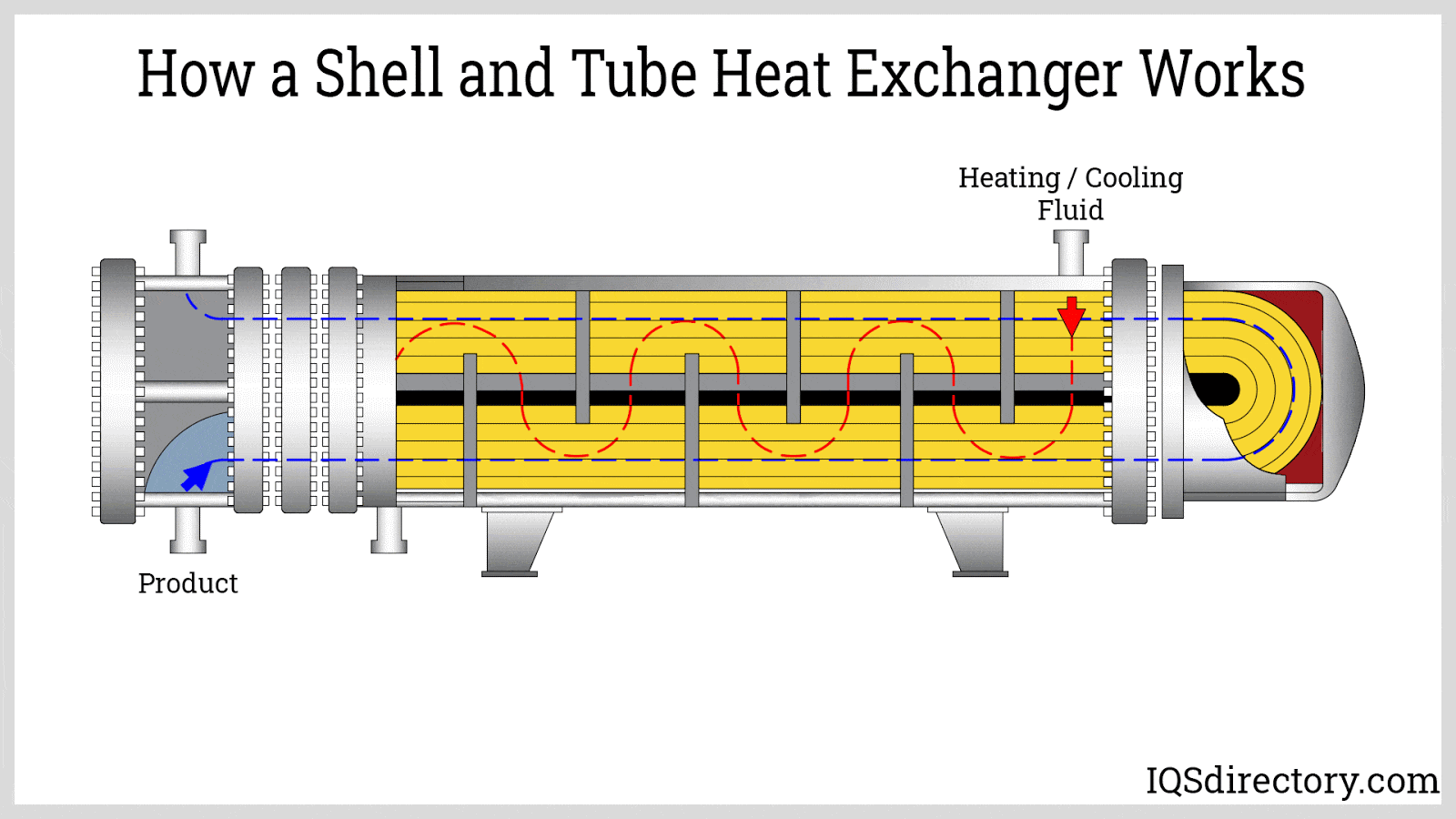 Heat exchangers, devices that transfer heat between fluids separated by a wall with high thermal conductivity to prevent mixing of the fluids.
Heat exchangers, devices that transfer heat between fluids separated by a wall with high thermal conductivity to prevent mixing of the fluids.
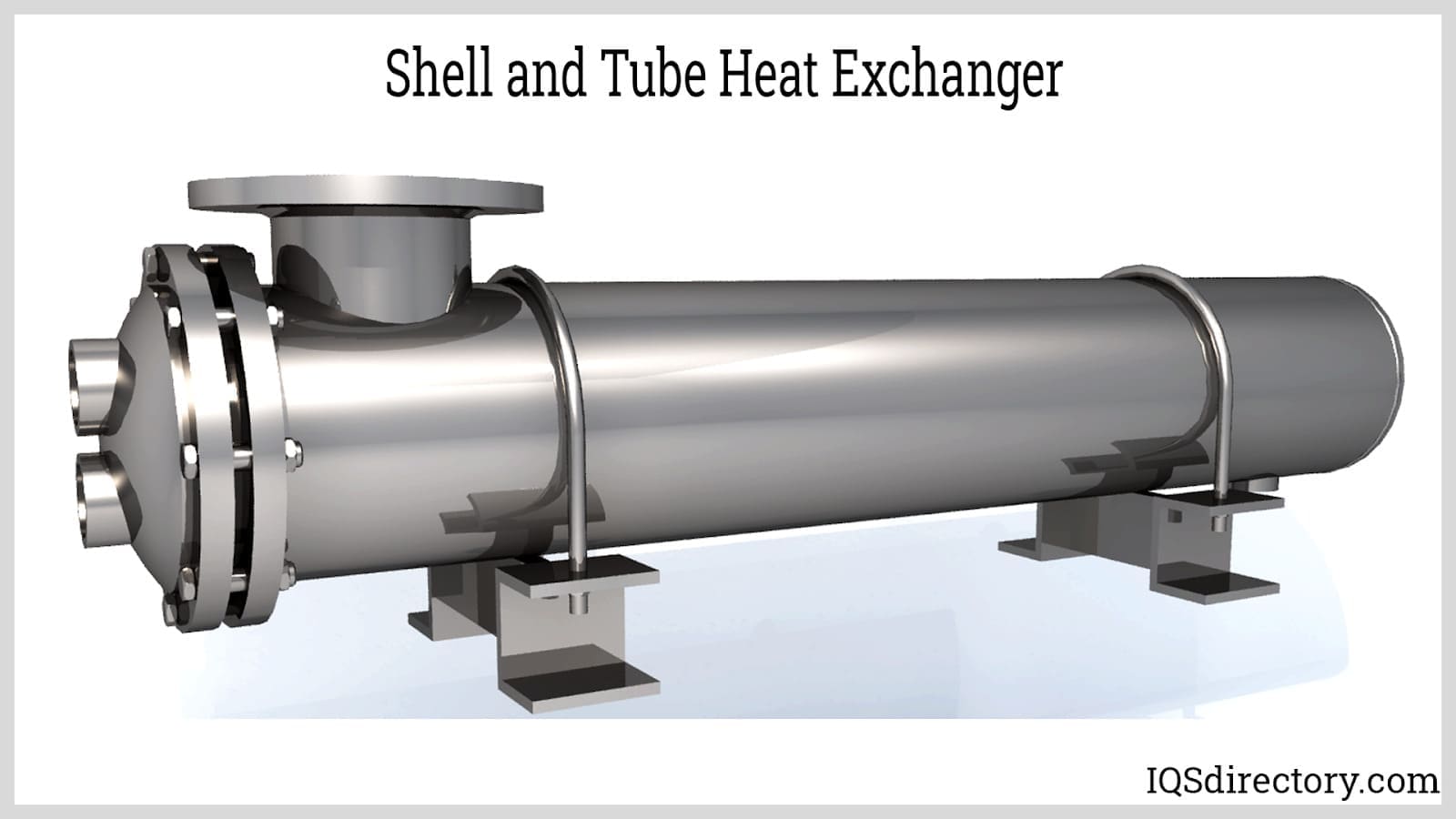 Shell and tube heat exchanger using a large cylindrical enclosure whaich has bundles of spaced tubing compacted in the interior.
Shell and tube heat exchanger using a large cylindrical enclosure whaich has bundles of spaced tubing compacted in the interior.
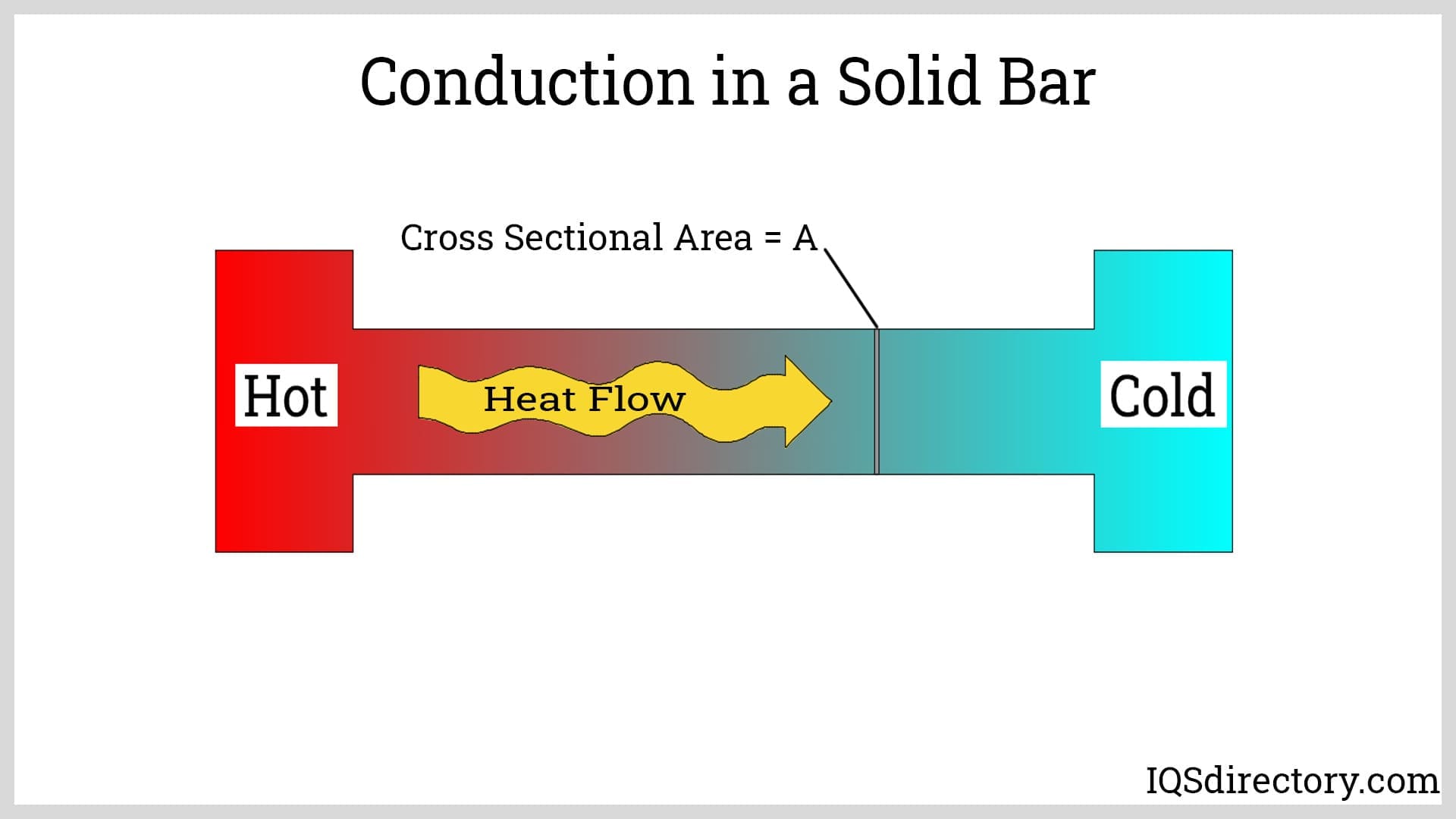 Transfering heat energy with molecules with high kinetic energy by direct collisions of adjacent molecules with lower kinetic energy.
Transfering heat energy with molecules with high kinetic energy by direct collisions of adjacent molecules with lower kinetic energy.
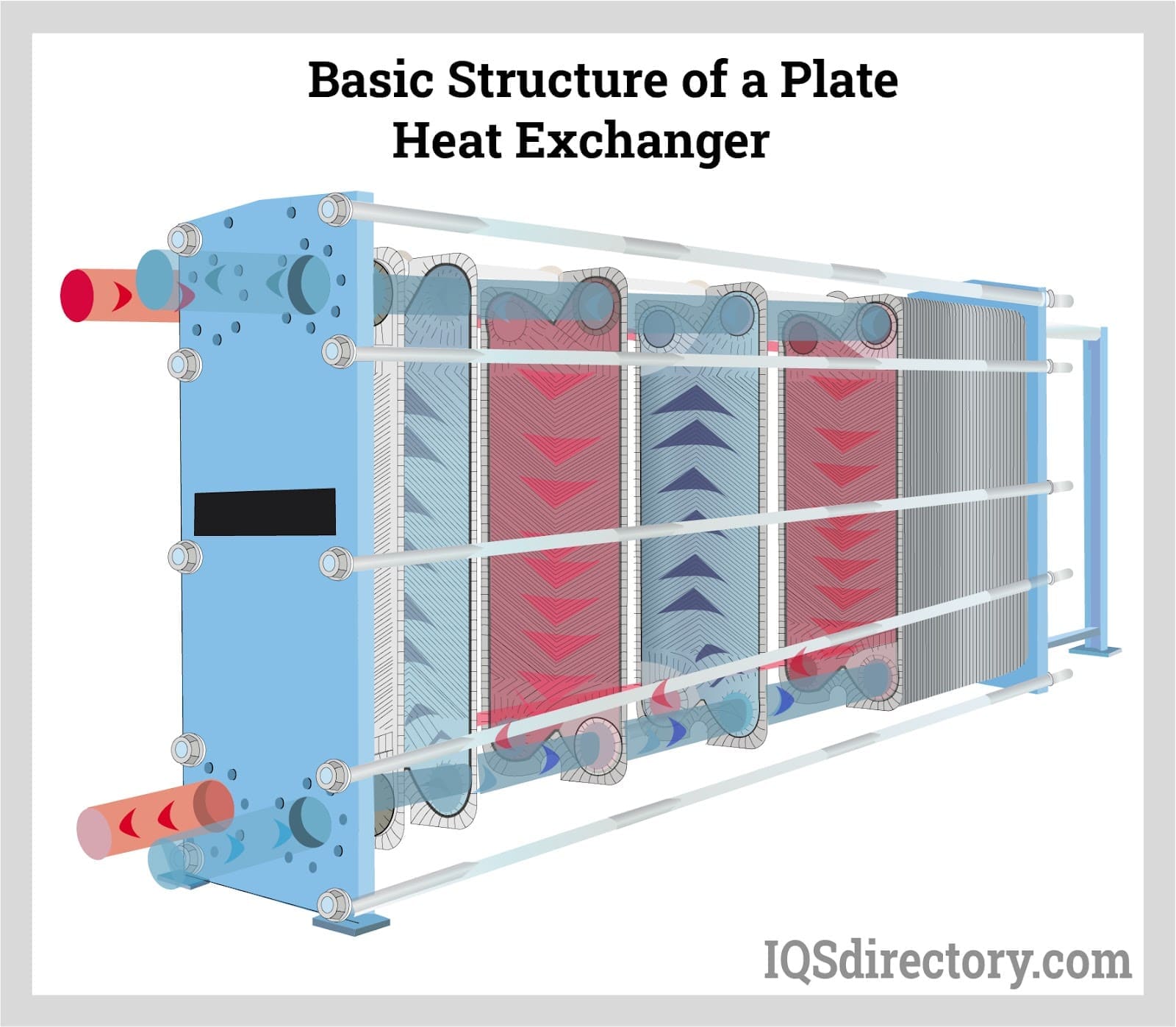 Plate heat exchanger a compact heat exchanger that uses a series of thin metal plates transfering heat from one fluid to another.
Plate heat exchanger a compact heat exchanger that uses a series of thin metal plates transfering heat from one fluid to another.
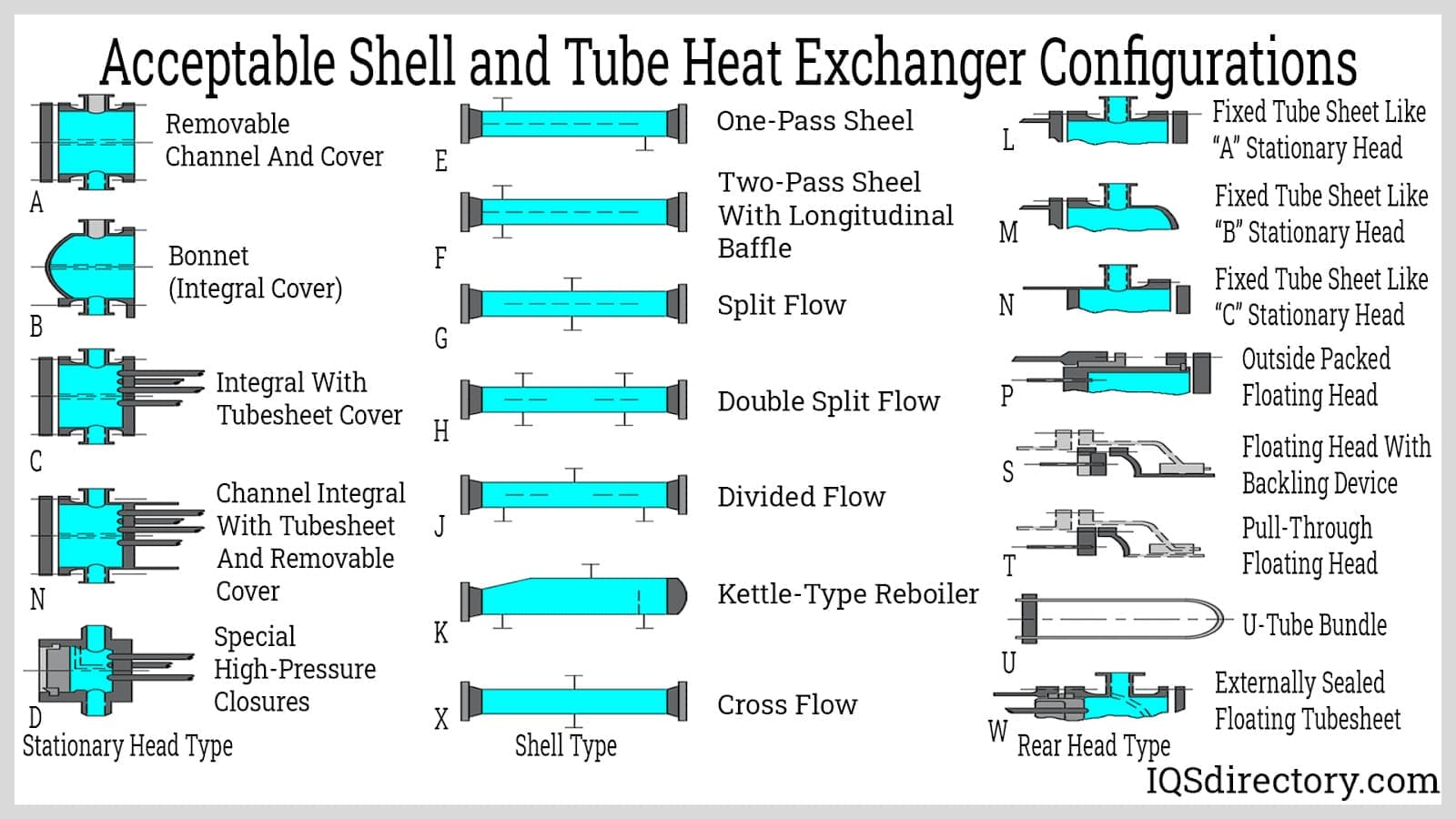 The different configurations for the cover, flow, and head of heat exchangers.
The different configurations for the cover, flow, and head of heat exchangers.
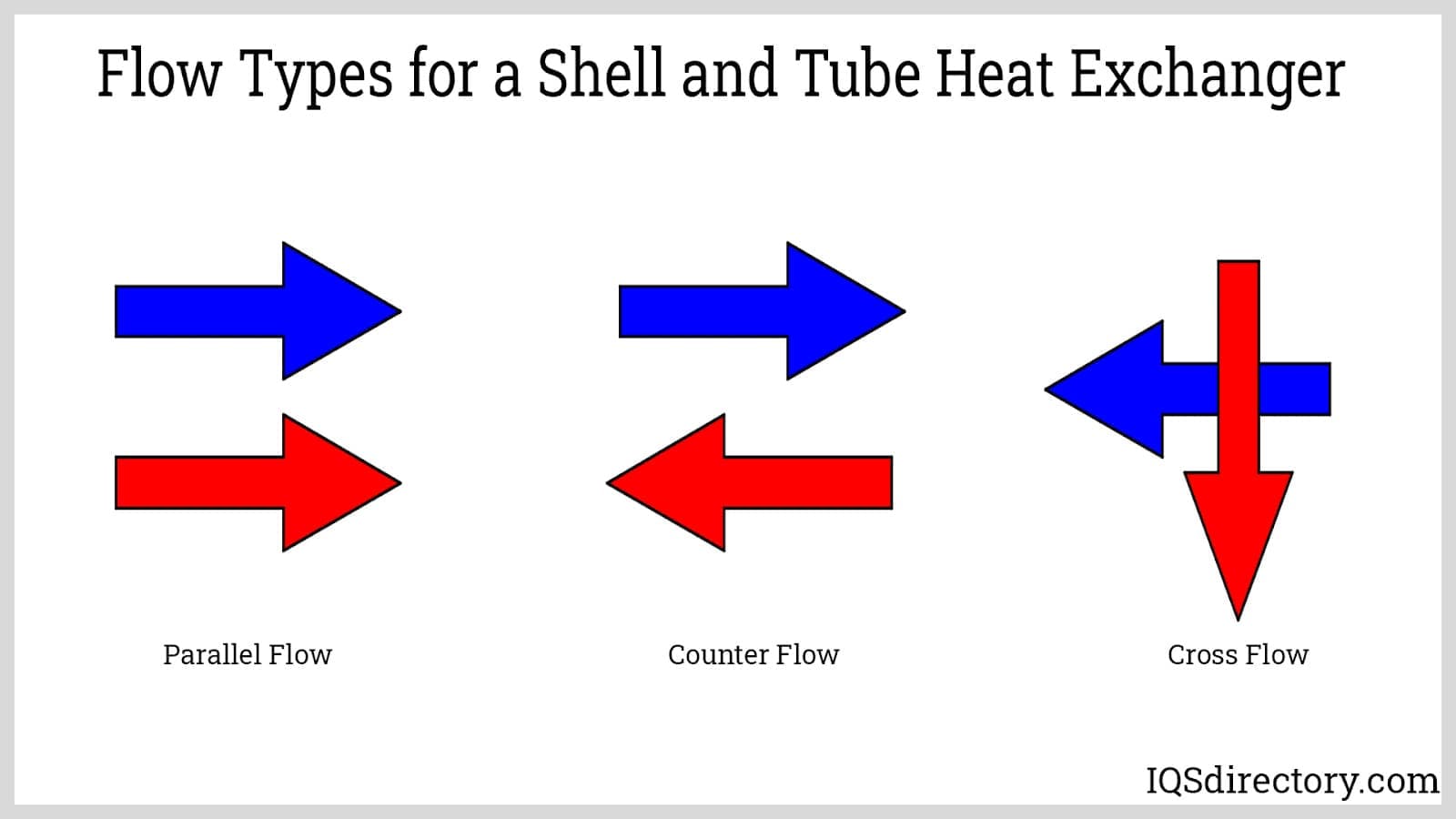 Classification process for heat exchangers is dividing them by their characteristics and one method is the flow directions either parallel, counter, or cross flow.
Classification process for heat exchangers is dividing them by their characteristics and one method is the flow directions either parallel, counter, or cross flow.
Types of Heat Exchangers
In a bid to understand the working of heat exchangers, we have to take a closer look at the two primary categorizations. The two approaches include flow configuration and equipment classification mainly by construction.
Heat Exchanger Classification by Flow Configuration
The four main types of flow configurations include:
- Counterflow
- Cocurrent Flow
- Crossflow
- Hybrid
- Counterflow
- There exist two types of fluids which flow in parallel but that takes place in different directions. The arrangement allows for a substantial temperature change of the fluids thus making it the most efficient. If you'd like to find companies who are making this type of exchanger, you can check out IQS Directory's list of manufacturers.
- Concurrent Flow
- In this heat exchanger design, the steam flows in parallel, but in this case, flow occurs in the same direction. However, the efficiency in this model of heat exchangers is low, but it provides uniformity in wall temperatures.
- Crossflow
- Offer intermediate capabilities between cross and countercurrent flow. In this flow configuration, fluid flows at right angles.
- Hybrids
- This model is common in industrial heat exchangers whereby they combine counterflow/co-current flow with multipass flow heat exchangers.
Heat Exchanger Classification by Construction
Classification according to design results into two main groups namely:
- Recuperative Heat Exchangers
- Regenerative Heat Exchangers
- Recuperative Heat Exchangers
- In this type of heat exchanger, they contain separate flow paths for the fluids. These fluids maintain a continuous flow simultaneously within the exchanger and thereby enabling heat exchange across the wall separating the fluids.
- Recuperative design offers a wide range of heat exchangers which can be grouped into three broad categories namely:
- The Indirect contact exchangers
- The Direct Contact Exchangers
- The Specials
- The Indirect Heat Exchangers
- In this category of heat exchangers, the steam or fluids are separated by a wall which is usually made of metal. They basically include:
- Tubular Heat Exchangers
- The Plate Heat Exchangers
- The Tubular Heat Exchangers
- Make it possible for a wide variety of pressure and temperatures to be used hence, they are more popular due to the design flexibility. Tube heat exchangers have a number of categories, but the most common one is the shell and tube exchanger model. Its design has gained a lot of preference in the modern industries. You can use this site to easily find tubular heat exchanger manufacturers.
- The Shell-and-Tube Heat Exchanger
- Made up of several tubes that are mounted on the inside of a cylindrical metal shell that facilitates heat exchange. The shell-and-tube heat exchanger allows for fluid to flow on the inside and outside of the tubes. Fluid flow happens in single phase or two-phase.
- The exchanger comprises of four major parts namely:
- The Frontend
- Part through which the fluid enters into the device.
- The Rearend
- Part through which the fluid exits.
- The Tube Bundle
- Comprise of tie rods and tube sheets for holding the bundle together.
- The Shell
- Comprises the tube handle.
- As a result of the popularity gained by the metal shell and tube, a standard has been initialized to monitor heat exchanger design and usage. This is known as the Tubular Exchanger Manufacturers Association (TEMA) standard. The material used in the manufacture of shell and tube heat exchanger is metal. However, other types of materials are used, and they include glass, plastics and graphite. Manufacturers are keen to ensure that the materials are durable, corrosion resistant. The metals which fulfill these aspects are stainless steel, titanium, steel, copper and cast iron.
- Furnaces
- The heating in this type of heat exchanger is either by electric heaters or burners.
- The Tube in Plate
- Their application is mainly in heat recovery and air conditioning. Plates act as the support and as well provide more surface area due to extensions.
- Electrically Heated System
- The fluid flows via the outside since the pipes contain intense heat from the electric heating.
- Air Cooled System
- Comprises of a fan system, bundle of tubes and supporting structures. Tubes have fins to increase surface area. A fan that is mounted above the bundle (induced draught) helps to suck air through the tube. These are mostly in application where there isn’t enough cooling water. This has similar operation in comparison to the air-to-air heat exchanger.
- Air-to-Air Heat Exchangers
- Replace stale indoor air with fresh air from outside, similar to how a fan might circulate air in a house.
- Brazed Plate Heat Exchangers
- Made up of specially formed plates, vacuum brazed together.
- Flat Plate Heat Exchangers
- Transfer heat through flat, corrugated plates.
- Gasketed Plate Heat Exchangers
- The most common. Elastomer gaskets are used in the plates, which contain the pressure and control the flow of each medium.
- Heat Pipes
- Mainly comprises of a working fluid as well as wack material. The fluid absorbs heat, then it evaporates and passes through the pipe to the end where it condenses and releases heat.
- Marine Heat Exchangers
- Designed for use on boats.
- Oil Coolers
- Heat exchangers that are specifically designed for the transfer of heat, or thermal energy, by carrying the oil through cooling units in order to cool.
- Agitated Vessels
- Play a crucial role in heating viscous fluids. These devices consist of a vessel that contains tubes inside as well as an agitator, like the helical ribbon impeller or propeller. The tube is for transporting the hot liquid while the agitator ensures uniform heat distribution through the cold liquid.
- Water to Air Heat Exchangers
- Devices used to transfer processed heat from water into the air.
- Water to Water Heat Exchangers
- Transfer heat energy from one liquid to another without bringing the two liquids into direct contact.
- Welded Plate Heat Exchangers
- Fully welded and require no gaskets. These are usually constructed of one material, generally stainless steel.
- Carbon Block Exchangers
- Come in handy in heating or cooling of corrosive fluids. They comprise of carbon steel blocks in which holes are drilled to enable fluid passage. The blocks are finally bolted together.
- Plate Heat Exchangers
- Plate heat exchangers by design separate the fluids using plates. The plates have increased surface area either by using fins or embossing. More so, they can be bolted, brazed or welded together. The plate exchangers are common in food processing and cryogenic industries. Due to their desirable aspects such as high surface area to volume ratio, ability to handle more than two types of steam and low fluid inventory, plate heat exchangers are being incorporated in the manufacturing of chemicals.
- They include:
- Plate and Frame Heat Exchangers
- Comprise of membranes to hold rectangular plates that have holes through which the fluid passes. A gasket functions to seal the plates together. They are very easy to disassemble for cleaning and for this reason, they are commonly used in the food industry. Also, the two plates can be welded together to eliminate the possibility of leakages. Brazed plate exchangers counter leakages through brazing.
- Plate-Fin Heat Exchangers
- Comprise of fins that are interlocked in between parallel joined plates. Fin arrangement is flexible to allow either parallel or cross-flow between adjacent plates. More so, they enable passing of around 12 fluid streams within a single exchanger by arranging the header rightfully. Plate-fin heat exchangers have gained preference in gas liquefaction since they can operate in close temperature limits.
- Lamella Heat Exchangers
- Bear a resemblance to the shell and tube model. They therefore comprise of tubes that are joined together forming a bundle. In this design, one of the fluids flows through the tube while the other flows through the gaps between the tubes. These exchangers are prevalent in paper industries.
- Spiral Plate Exchangers
- Developed through winding of two flat and parallel plates forming a coil. The terminals are either welded or sealed with a gasket. Their usage lies in viscous, heavy fouling fluids or fluids that contain particles or fibers.
- Steam Coils
- A type of heat exchanger that utilizes steam on a coil to transfer heat to a particular area. Since steam is relatively inexpensive many will turn to this style of heat exchanger. Steam coils are typically manufactured from reliable materials such as stainless steel.
- Coil Heat Exchangers
- Work to increase or decrease the heat of fluids. They may facilitate exchanges between two liquids, a liquid and a gas or vapor or two gases or vapors. Coil heat exchangers, again, like many of their cousins, are built to disallow any physical contact between the substance being cooled and the substance doing the cooling.
- Direct Contact
- Do not make use of the heat transfer surface. However, to use the design with two fluids, they ought to be immiscible. For usage of one type of fluid, it has to undergo a phase change.
- An example is the cooling system used in power generation. The cooling water is sprayed from the top onto the packing and in the meanwhile, air passes via the packing bottom. A disadvantage of this model is that the cooling water needs to be continuously replenished as a result of high evaporation. For maximum efficiency, water has to be maintained in a constant state.
- Specials Air Heat Exchangers
- Consists of two air heat exchangers that are:
- The Wet Surface Exchanger
- Here, water is used for cooling, then a fan is used to suck air and water through the bundle. The system is confined and therefore dump air is released to the surroundings.
- Scraped Surface Exchangers
- Comprises of a jacket-like vessel that allows flow passage as well as a rotary scraper that clears deposits from the inner walls. These are prevalent in pharmaceutical and food industries since deposits are formed on the heated walls.
- The Regenerative Heat Exchangers
- Here, the flow path is designed to contain a matrix that acquires heat through contact with hot fluid. The resultant heat is therefore passed along to the other fluid.
- They are commonly used in gas heat recovery at power stations. They are further classified into two namely:
- Static
- Dynamic
- It is worth noting that regenerative heat exchangers pose the possibility of cross-contamination of streams of different temperature. For this reason, they are less preferred compared to recuperative exchangers.
- Static Regenerators
- This heat exchanger type, as the name suggests, contains no moving parts except for valves. Here, hot gas flows past the matrix, then change happens, whereby flow is halted allowing the cold gas to pass through.
- Dynamic Regenerator
- In this model, there exists rotating elements whereby a central packing rotates within. Therefore, there is a simultaneous flow of cold and hot gas.
Maintenance for Heat Exchangers
- For plate and frame exchangers, they can be maintained by disassembling and doing cleaning periodically.
- Monitoring to point out the heat transfer coefficient which tends to decrease with time as a result of fouling. Fouling is resultant of impurity deposition within the exchanger.
- Tube exchangers are cleanable through some methods like bullet cleaning as well as high pressure water. The water jet will flush out the foreign objects.
- Tubular heat exchangers are cleanable through some methods like bullet cleaning as well as high pressure water. The water jet will flush out the foreign objects.
- Fouling of heat exchanger systems can be minimized through water treatment and addition of chemicals.
- Water borne oscillations technology is being adapted to eliminate biofouling.
Things to Consider When Choosing a Heat Exchanger
- Heat Exchanger Manufacturers
- Before settling for a particular manufacturer, it's important to consider the below factors:
- How long has the manufacturer been in business?
- Do they have a good business reputation?
- What materials do they use in the manufacture of the heat exchangers?
- Do they have a good distribution network?
- Are they in a position to deliver your order promptly and with top quality assurance?
- The above clarifications should help you make an informed choice about the right manufacturer that can effectively address your needs.
- Mechanical Considerations
- In the design of heat exchangers, any model that tends to operate above the atmospheric pressure has to adhere to a code known as the ASME code (American Society of Mechanical Engineers). The stated codes are of essence in laying out the requirements for the pressure vessels.
Heat Exchanger Terms
- 1, 2, 4 Pass
- The number of times, one, two or four, the liquid passes through the tube bundles of heat exchangers. Anything greater than a one pass is considered a multi-pass unit.
- Baffle Plate
- Plate the tubes pass through for support that provides a blocked path for the shell side flow, which forces the flows across the tubes and improves the performance of heat transfers. These heat exchangers are shaped in various ways, but are basically segmental.
- Baffle Spacing
- The space between the tube bundle baffle plates that is adjusted to maximize effectiveness of heat exchangers.
- Bonnet
- Like a channel with straight tubes but without a removable cover. These heat exchangers do not have divider walls and are found at each end of heat exchangers.
- Bonnet Assembly
- Manages the tube side liquid for circulation through heat exchanger tubes. This can also hold the tube side inlet and outlet connections and/or pass ribs.
- Box Linear Style
- Tubes of heat exchangers parallel to each other from the inlet to the outlet manifold.
- Bundle Assembly
- The tubing assembly in removable bundle heat exchangers. This typically includes tubes, tube sheets, baffles, spacers and tie rods.
- Cap Screw
- A threaded bolt that holds the bonnet onto the core of some types of heat exchangers.
- Channel
- A kind of front end with a removable cover from which the tube side flows in and out. A dividing wall separates the inlet and outlet flow.
- Channel Assembly
- Same function as a bonnet assembly, except that the cover is removable and provides access to the ends of the tubes.
- Collector
- What the tubes in heat exchangers drain into.
- Core Assembly
- The shell and tube assembly in fixed tube sheet heat exchangers.
- Coupling
- The parts that connect the piping to the heat exchangers, come in many varieties.
- Cover/Cover Assembly
- Used to cover openings on heat exchangers. Covers are different from end plates because they can be removed to clean the interior of the tube side, without distressing any piping.
- Cradle Assembly
- The part used to support heat exchangers and to secure it to the mounting surface when welded or strapped to the shell. Cradles may be fixed or moveable.
- Design Pressure
- Calculations of part thickness and design of heat exchangers based on the most severe conditions or highest operating pressures seen by heat exchangers, to make the pressure slightly higher.
- Dome
- A type of nozzle connection that provides a larger nozzle opening between the pipe size and tube bundles of heat exchangers, typically to prevent tube erosion due to high inlet velocities.
- End Plate
- Covers welded to heat exchangers. The majority of end plates are used on bonnet assemblies.
- End Zone
- The first baffle space on a tube bundle, occurring between the tube sheet and the first baffle plate. It is adjusted to maintain the baffle plates within the two shell side nozzles.
- Ferrule
- A small copper or stainless steel piece of tubing that is crimped or squeezed onto the tie tube, up against the last baffle, and locks the baffles into position.
- Fixed Tube Sheet
- A tube sheet that is an essential part of the core shell assembly of heat exchangers.
- Floating Tube Sheet
- Placed at one end of a removable tube bundle and allowed to move freely with the expansion and contraction of the tube bundle due to temperature changes in operation. It always has a smaller diameter than the immobile tube sheets.
- Gasket
- A device used between two parts that helps prevent leakage in heat exchangers.
- Heat Transfer Equipment
- Devices that are utilized for transferring heat from one medium to another medium. There are several types of heat transfer equipment each with their own distinct advantages and disadvantages. When selecting the proper type of heat transfer equipment for an application there are several factors that should be considered.
- Impingement Plate
- A small perforated-plate or bar assembly in the shell-side nozzle that can also be attached directly to the bundle. This protects and prolongs tube life by breaking up and slowing down the shell side fluid, which slows the erosion of the tubing.
- In and Out End
- The side of heat exchangers that contains the tube side inlet and outlet connections in a multi-pass unit.
- Lantern Ring
- A metal or nylon ring on some packed joint heat exchangers that holds the packing rings in place.
- Operating Pressure
- The pressure of heat exchangers during operation and while in use.
- Packed End
- The end of heat exchangers, which contains the packed joint and the packing rings.
- Pass Lane
- A lane in a tube layout where there are no tubes and where the pass ribs mate.
- Pass Rib
- A separator plate inside a bonnet or channel that merges with the pass lane surface, used to form multi-pass heat exchangers. By arranging the ribs, a designer can direct the flow of the tube side substance.
- Protector Rod
- Protects the parts of heat exchangers (tubes, tube sheets and bonnets) from corrosion by acting as a sacrificial anode so that when water is flowing through the tube side it is consumed instead of other parts of heat exchangers.
- Range Temperature
- The temperature difference of a single fluid as it flows through heat exchangers.
- Removable Bundle
- Heat exchangers with a removable tube bundle from the shell casing. This provides easy cleaning of the shell side and also a more feasible way of replacing depleted tubes.
- Reversing End
- The end of multi-pass heat exchangers where the tube side fluid reverses its flow. This usually contains only small vent and drain connections.
- Shell
- The container where the tube bundle is placed and is the conduit for one of the fluids in heat exchangers.
- Shell Assembly
- The assembly into which the tube bundle is placed. It also houses the shell side connections.
- Shell Head
- A formed plate that is welded to the shell (or bonnet) pipe. It comes in many styles and shapes, including flanged and dished, elliptical, ellipsoidal and hemispherical.
- Shell Side
- The part of heat exchangers where the fluid circulates around the tubes.
- Spacer
- Tubing that holds the baffle plate in place.
- Stacking
- Two or more heat exchangers connected together side by side or one on top of the other. Interconnecting piping hooks these heat exchangers together.
- Stationary Tube Sheet
- The tube sheet at one end of a removable bundle that has a larger diameter than the floating tube sheet. The stationary tube sheet is held in a permanent position between the bonnet and shell flanges.
- Stuffing Box Flange
- A flange used at a packed end joint. When a packed joint is tightened, the packing ring is forced into this by the lantern ring/lantern gland.
- Support Foot
- Bolted to heat exchangers using bonnet to shell flange bolting.
- Test Pressure
- Test that detects leaks on the joints of heat exchangers.
- Tie Rods
- Bars mounted between the tube sheets to support the baffles.
- Tie Tube
- A tie tube takes the place of the tie rod in small diameter heat exchangers, and serves the same purpose.
- Tube
- A flow channel for one of the fluids in heat exchangers. These heat exchangers are often parallel within the shell to provide a large surface area for heat transfers.
- Tube Layout
- Shows the positioning of the tubes inside heat exchangers and the locations of the tie rods.
- Tube Sheet
- The apparatus that the tubes are affixed into that holds them in place. It also provides a seal between the tube-side and shell-side liquid.
- Tube Side
- The fluid that circulates through the inside of the tubes of heat exchangers.